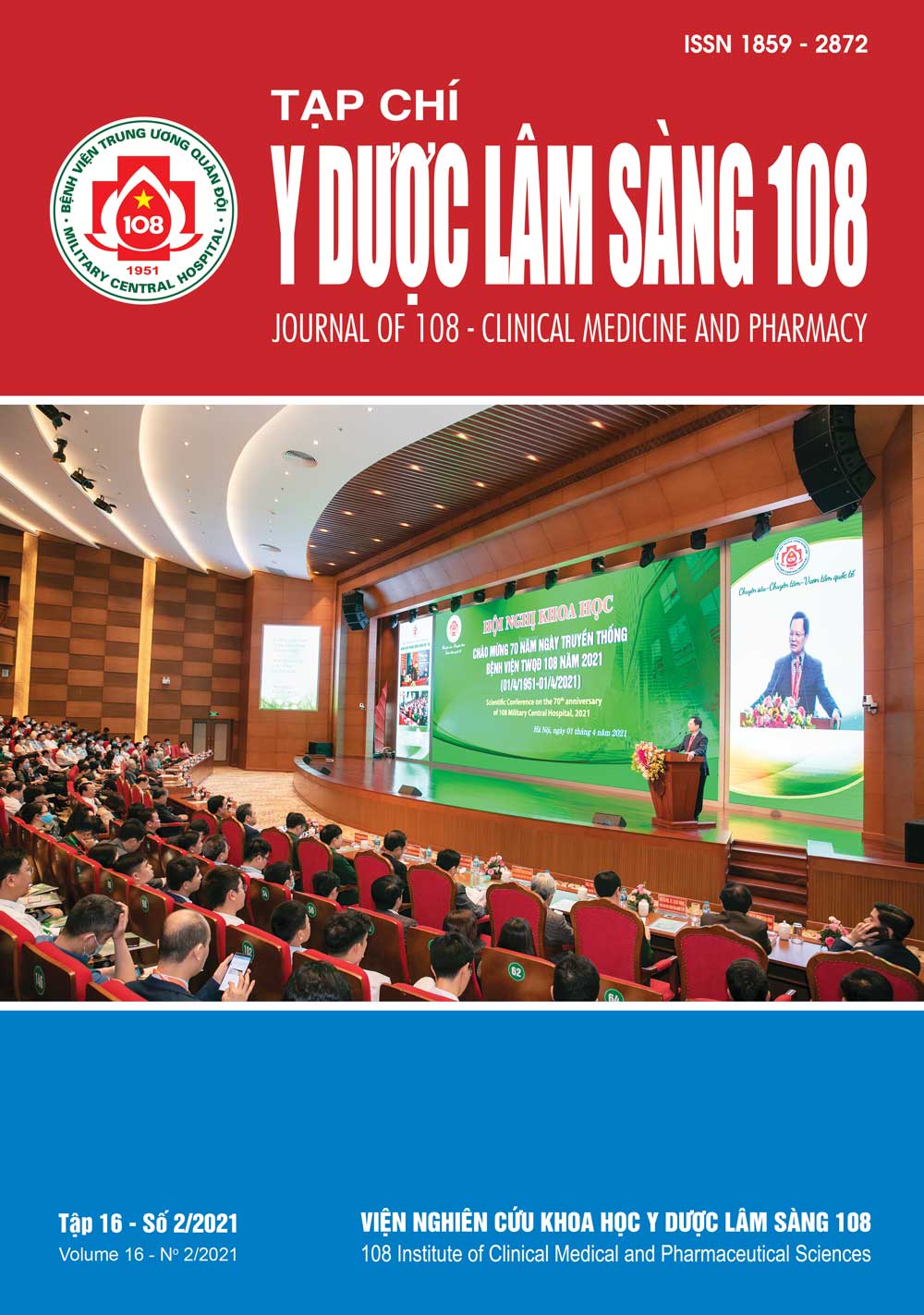Thực trạng sử dụng kháng sinh colistin trên bệnh nhân lọc máu liên tục tại Bệnh viện Trung ương Quân đội 108
Main Article Content
Keywords
Tóm tắt
Mục tiêu: Mô tả đặc điểm lâm sàng, vi sinh và đặc điểm sử dụng colistin trên bệnh nhân lọc máu liên tục tại Bệnh viện Trung ương Quân đội 108. Đối tượng và phương pháp: Hồi cứu mô tả trên 45 bệnh án có sử dụng đồng thời colistin và liệu pháp lọc máu liên tục tại Bệnh viện Trung ương Quân đội 108 từ tháng 1/2018 đến tháng 5/2020. Kết quả và kết luận: 66,7% bệnh nhân từ 60 tuổi trở lên. Các bệnh nhân điều trị chủ yếu tại Khoa Hồi sức tích cực (84,4%). Có tổng số 57 đợt lọc máu liên tục với lý do chủ yếu là sốc nhiễm khuẩn (86,0%). Căn nguyên vi sinh phổ biến nhất là A. baumannii (46,7%). Một số chủng E. coli, A. baumannii và K. pneumoniae đã xuất hiện MIC ≥ 4mg/L. Nhiễm khuẩn phổ biến nhất là viêm phổi (97,8%). 39/45 bệnh nhân sử dụng liều nạp colistin với liều nạp trung bình là 6,5 ± 1,9MIU. Trong những ngày lọc máu liên tục, liều duy trì phổ biến nhất là 2MIU mỗi 8 giờ. Hơn một nửa số ngày nằm ngoài đợt lọc máu liên tục có liều duy trì thấp hơn khuyến cáo. Tỷ lệ bệnh nhân đáp ứng hoàn toàn/một phần, không đáp ứng với phác đồ colistin lần lượt là 35,6% và 64,4%. Từ kết quả nghiên cứu cho thấy, cần xây dựng quy trình ghi chép đầy đủ các chỉ số đặc điểm của bệnh nhân cũng như các thông số CRRT, đồng thời, tối ưu hoá liều colistin theo cá thể bệnh nhân và theo quá trình lọc máu liên tục.
Article Details
Các tài liệu tham khảo
2. Nguyễn Thu Huyền (2020) Triển khai hoạt động của dược sĩ lâm sàng vào việc sử dụng colistin tại Bệnh viện Trung ương Quân đội 108. Đại học Dược Hà Nội.
3. Bugge JF (2001) Pharmacokinetics and drug dosing adjustments during continuous venovenous hemofiltration or hemodiafiltration in critically ill patients. Acta Anaesthesiol Scand 45(8): 929-934.
4. Golper TA, Marx MA (1998) Drug dosing adjustments during continuous renal replacement therapies. Kidney Int Suppl 66: 165-168.
5. John Kellum, Rinaldo Bellomo et al (2016) Continuous renal replacement therapy. Pittsburgh Critical Care Medicine (2 ed.). Oxford University Press.
6. Leuppi-Taegtmeyer AB, Decosterd L et al (2019) Multicenter population pharmacokinetic study of colistimethate sodium and colistin dosed as in normal renal function in patients on continuous renal replacement therapy. Antimicrob Agents Chemother 63(2):e01957-18.
7. Mohamed Ami F, Karaiskos Ilias et al (2012) Application of a loading dose of colistin methanesulfonate in critically ill patients: population pharmacokinetics, protein binding, and prediction of bacterial kill. Antimicrobial Agents and Chemotherapy 56(8): 4241-4249.
8. Nation RL, Garonzik SM et al (2017) Dosing guidance for intravenous colistin in critically-ill patients. Clin Infect Dis 64(5): 565-571.
9. Schetz M, Ferdinande P et al (1995), Pharmacokinetics of continuous renal replacement therapy. Intensive Care Med 21(7): 612-620.
10. Spapen H, Laethem J et al (2019) Treatment of ventilator-associated pneumonia with high-dose colistin under continuous veno-venous hemofiltration. J Transl Int Med 7(3): 100-105.
11. Tsuji BT, Pogue JM et al (2019) International Consensus Guidelines for the Optimal Use of the Polymyxins: Endorsed by the American College of Clinical Pharmacy (ACCP), European Society of Clinical Microbiology and Infectious Diseases (ESCMID), Infectious Diseases Society of America (IDSA), International Society for Anti-infective Pharmacology (ISAP), Society of Critical Care Medicine (SCCM), and Society of Infectious Diseases Pharmacists (SIDP). Pharmacotherapy 39(1): 10-39.
12. Wallace SJ, Li J et al (2012) Interaction of colistin and colistin methanesulfonate with liposomes: Colloidal aspects and implications for formulation. J Pharm Sci 101(9): 3347-3359.
 ISSN: 1859 - 2872
ISSN: 1859 - 2872
